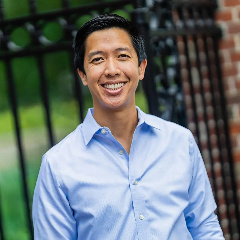 Andrew Ho, Charles William Eliot Professor of Education, is a psychometrician whose research focuses on the design and use of test scores in educational policy. Given his scholarly interest in assessment, Ho feels the pressure to “practice what I preach” in his teaching to ensure that assessments offer opportunities for student learning. In his statistics courses, Ho aims for assessments to be “genuine, relevant, and engaging acts of learning” that simulate the work educational statisticians do. He argues that it is crucial for faculty to have clarity of purpose when measuring student learning, and suggests all faculty consider the question: “Why are you assessing?”
Andrew Ho, Charles William Eliot Professor of Education, is a psychometrician whose research focuses on the design and use of test scores in educational policy. Given his scholarly interest in assessment, Ho feels the pressure to “practice what I preach” in his teaching to ensure that assessments offer opportunities for student learning. In his statistics courses, Ho aims for assessments to be “genuine, relevant, and engaging acts of learning” that simulate the work educational statisticians do. He argues that it is crucial for faculty to have clarity of purpose when measuring student learning, and suggests all faculty consider the question: “Why are you assessing?”
Assessment as a learning tool
The benefits
Particularly given his role in a professional school, Professor Ho sees teaching the norms of applied statistics as an important component of the learning. For many assignments, he requires students to work in pairs because partnerships are the most common way of conducting quantitative research in education. Assigning authentic tasks, such as having students work with real-world data motivated by research questions, allows educators to maximize student learning and engagement. Ho argues that the most effective way to encourage a growth or improvement mindset is for students to see and feel themselves becoming more fluent in the material.
“The goal is not just assessment of learning, but assessment as learning. The intention is to engage students in the act of doing educational research, not simply testing whether they know a small sample of information.”
The challenges
Assigning grades has traditionally been the primary purpose of assessment, so shifting the expectations around why and how we test students is challenging. Ho argues that the perceived importance and permanence of grades skews how students engage with course materials. On the one hand, grades can motivate student engagement as a signal of the quality of their performance to external audiences. Yet when used formatively and to deliver ongoing feedback to students, assessments can encourage one’s intrinsic motivation to learn.
Takeaways and best practices
-
Reframe assessment.
Ho encourages faculty to consider reframing assessments to be less focused on the extrinsic purpose of assigning grades and more focused on how students can demonstrate skills and growth. In his courses, students complete ongoing weekly assignments, culminating in a large final assessment known as the “Celebration of Learning.” The intent is to reframe final exams as opportunities for students to see—and hopefully celebrate—how much they’ve learned over the course of the semester. -
Be intentional.
Assessments should have a clear purpose. Students should understand not only what instructors are asking them to do but why they are asking them to do it. Faculty should be intentional not only about what material students are tested on, but about how questions are asked. In his course, EDU S052: Intermediate and Advanced Statistical Methods for Applied Educational Research, the final exam period is split into two parts. First, students receive statistical output to review in collaboration with their peers, mirroring authentic research practices. From these materials, students anticipate what the test questions will be on their culminating exam. In the second phase, students receive the test questions and work independently to complete the assessment. -
Make assessments relevant.
Faculty should consider how assessments can be designed to simulate real world tasks that allow students to practice skills whose relevance they can explain, rather than skills whose relevance seems abstract. In his spring course, EDU S061, Ho conducts an oral exam to emphasize the learning goal of having authentic conversations about psychometric methods among expert peers. He believes it encourages students to study in a different way and leave confident that they can converse about technical topics. He also observes that it is a "ChatGPT-proof" form of assessment in this AI era.
Bottom line
To innovate with respect to assessment, faculty should be clear about the purpose of testing in their courses and aim to create assignments that are authentic and relevant representations of the learning goals.
